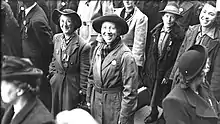Maire Comerford
Máire Aoife Comerford (1893-1982) was an Irish republican from County Wexford who witnessed central events in 1916-23 and remained a committed supporter of Cumann na mBan until her death.
Early career to 1916

Comerford was born as Mary Eva Comerford on 2 June 1893 in Rathdrum, County Wicklow to a middle-class family. Her parents were James Comerford, a flour and corn miller, and Eva Mary Esmonde. Her grandfather, Thomas Esmonde was awarded a V.C. for bravery in the Crimean war in 1854. On his return to Ireland he joined the Royal Irish Constabulary and was promoted to Deputy Chief Inspector. Her father James Comerford was the owner of the Comerford Mill in Rathdrum. She had two brothers (Thomas and Alexander) and one sister (Dymphia).
Her father died when she was sixteen and in 1911 she was sent to London to a secretarial school. During this time she stayed in the Ladies club in Eccles Place. She returned to Ireland to live along with her mother in the home of her uncle in Wexford, T. L. Esmonde, around 1915 her mother rented a house in Courtown, Co Wexford to set up a school.
She was in Dublin during the outbreak of the 1916 Easter Rising in Dublin and volunteered to aid Countess Markievicz in St Stephen's Green, but was turned away and carried despatches for the GPO garrison. She returned to Gorey after the rising and joined the local Sinn Féin branch where she worked alongside Sean Etchingham.
She returned to Dublin shortly before the 1918 General election, where she worked on Roger Sweetman's election campaign. On 21 January 1919 she attended the Round room at the Mansion House, witnessing the creation of the First Dail by the twenty-seven TDs present.[1]
1916-1922
Comerford supported the prisoners taken in 1916 and the reordering of the Sinn Féin party from 1917. It won a majority in the election of December 1918 and she was an observer when the First Dail was inaugurated on 19 January 1919. Supporting the IRA in the Dublin area during the Irish War of Independence, she also helped to run the Irish White Cross, led by the Quaker James Douglas, which aimed to assist civilian war victims by raising money in the United States.
Civil War
Before the Irish Civil War of 1922-23, Cumann na mBan had voted by 419-63 against the terms of the Anglo-Irish Treaty and wanted to maintain the Irish Republic. However this vote was taken after the Treaty had been approved by the Dáil on 7 January. In June 1922 she managed to escape from the Four Courts during the Battle of Dublin. The war further split the Sinn Féin movement, and in 1923 Comerford was arrested and held at the women's section of Mountjoy Prison.
In later years she felt that Éamon de Valera's suggestion in America in 1919-20 that Ireland's future relationship to Britain would be about the same as that of Cuba to the USA had started the mentality of compromise that had led on to the Treaty signed in 1921.
Republican politics
Following the civil war Comerford supported Éamon de Valera and his abstentionist Republican candidates, but split with him (as did MacSwiney) when he entered the Dáil in 1927. In 1926 he had established the Fianna Fáil party, which drew off a number of Cumann na mBan supporters and weakened it thereafter. She remained a member of what was from now on generally seen as a committed group which would not compromise in terms of everyday politics on constitutional matters. She never married.
In 1935-65, despite their political differences, she worked as a journalist at de Valera's newspaper the Irish Press. In 1967 she worked on the restoration of the Tailors' Hall in Dublin with the Irish Georgian Society, which had housed Wolfe Tone's nascent republican parliament in the 1790s. In 1969 her book 'The First Dáil' was published by Joe Clarke. In the 1970s and up to her death she supported the Provisional Irish Republican Army war in Northern Ireland, in particular its hunger strike campaign. In 1976 she was interviewed for the 'Curious Journey' television documentary with other survivors of the 1914-23 period, later published as a book. She worked as a journalist until her retirement in the 1960s.
Máire died on 15 December 1982 aged 89 and was buried in Mount Saint Benedict Cemetery in Gorey, Co Wexford.
References
- Dail roll 21 January 1919 Archived 19 November 2007 at the Wayback Machine
